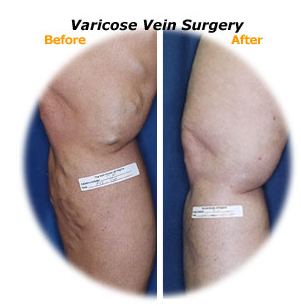VaricoseThe operation is usually performed under a general anaesthetic and you are asleep and unaware throughout the procedure. The commonest operation (high tie or saphenofemoral ligation) is where a cut is made in the groin over the top of the main varicose vein. This is then disconnected where it meets the deeper veins (femoral vein). A main varicose vein (greater saphenous vein) on the inner aspect of the leg is then removed (stripped). I use ultrasound guided tumescent anaesthesia along the vein to be stripped. This technique minimises any discomfort but also significantly reduces any bleeding into the track that remains after the vein has been removed. 
Stripping the greater saphenous vein was shown to decrease the risk of re-operation by 60%, although it did not affect the risk of recurrent varicose veins in this study. Blood can still flow up the leg along deeper, unaffected veins. The cut in the groin is closed with a stitch. Other veins marked before the operation are then pulled out of tiny cuts (avulsions). These cuts are usually only 2-3 mm long and are closed with adhesive strips and only occasionally with stitches. Modern varicose vein surgery, with ultrasound planning and ultrasound available in theatre is far removed from procedures performed n the past. There are newer techniques available to ablate the greater saphenous vein (GSV) in the thigh, without physically removing the vein. These techniques are VNUS radiofrequency ablation (RFA) and endovenous laser ablation (EVLT). Both seem to be effective in the short to medium term and may ultimately become established procedures as effective as conventional surgery. At present the durability of these procedures in the longer term is unknown, they require expensive additional equipment and do not physically remove the GSV. Although EVLT can ablate the GSV , longer term follow up has not been performed in large numbers of patients. Consequently, EVLT has not been adequately compared with the gold standard of conventional surgery and results may deteriorate with longer term follow up. There are also many different EVLT lasers on the market all with their own theoretical advantages and proponents and with different working wavelengths. RFA is a promising technique particularly with the newer ClosureFast technology. Neither EVLT or RFA have been shown more effective than tried and tested surgical techniques. It is also important to remember that EVLT and VNUS Closure are a replacement for the high tie and stripping part of conventional surgery. Separate procedures are required to deal with any other varicose veins and this may take the form of foam sclerotherapy or surgical phlebectomy. One particularly awkward situation to treat with EVLT or RFA is the patient who has sizeable veins running across the front and outside of the thigh (antero-lateral thigh veins). If these originate right at the sapheno-femoral junction then EVLT or RFA will not be effective. One recent report on VNUS radiofrequency ablation has rather worryingly highlighted a high rate of deep venous thrombosis (16% or 1 in every 6 patients), many of whom required significant intervention, but this does not seem to have occurred in other practices. A further new technique to remove bunches of varicose veins in the leg especially the calf is also available. The Triflex device involves sucking many of the veins out of the leg using a custom made instrument. This technique appears to have no particular advantage and has not been shown to be superior to conventional avulsions and still involves making cuts in the leg. Some other veins may also be affected, especially a vein behind the knee and a similar operation to that in the groin may need to be undertaken at this site (saphenopopliteal ligation). EVLT can also be used to treat the small saphenous vein at this location. A coating of skin glue will be placed on the cut in the groin, and your leg will be bandaged up to the top of the thigh. The bandages put on at the operation will stay on your leg until the following day when they are changed to stockings. Regimes vary slightly between different surgeons. |

+91 - 95661 39630
+91 - 94441 68963



